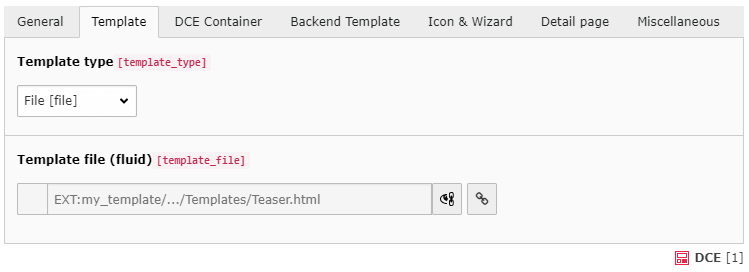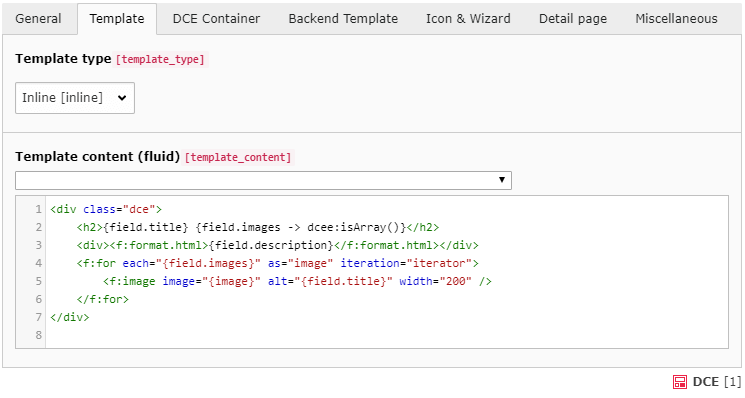Template¶
On this tab, you define the template which is used for displaying the content of the DCE in the FE. You can use the full power of Fluid at this place.
Template type¶
Tip
There are several templates a DCE can have. These options apply to all of them.
File¶
The option File let you choose a file that contains the Fluid content that should be used as the template for this DCE. The file name is selected in the “Template file (fluid)” input field.
This option makes it possible that you put the templates under revision control due to the fact that the files are stored in the file system.

The EXT: syntax is supported and encouraged to use, to point to template files provided by a template extension.
Inline¶
The default template type Inline let you directly edit the content of the Fluid template inside the code mirror editor of the “Template content (fluid)” entry field.

No namespace declaration¶
Since DCE 2.0 you do not need to provide the namespace declaration in each template. “dce:” is registered globally as available namespace in Fluid templates.
So this is deprecated:
{namespace dce=ArminVieweg\Dce\ViewHelpers}
<div class="dce">
Your template goes here...
</dce>
Just skip the namespace line. But it is not problematic when this line is still left in the template.
Dynamic Templating¶
With the select box in the “Template content (fluid)” section you can insert variables and view helpers into the template. The selected variable or view helper is inserted at the current cursor position in the template.

There are several groups inside the select box, which offers you help to work with Fluid:
- Available variables
- Available base variables
- Famous view helpers
- DCE view helpers
Available variables¶
- This group shows all previously defined variables. You have to save the DCE before newly created fields appear in the
- dropdown field. All custom variables are available with:
{field.nameOfVariable}
Available base variables¶
Besides the custom created variables, they are also some variables existing which are available in all DCEs:
{dce}- The DCE object. To access field values use:{dce.get.fieldName}{contentObject}- The content object row, this DCE instance is based on. It contains all tt_content properties.{TSFE}- The TypoScript frontend controller{page}- Properties of the current page{tsSetup}- TypoScript setup of the current page
Famous view helper¶
This group lists often used view helpers provided by Fluid itself. Detailed information about the Fluid view helper you will find in the official TYPO3 documentation
- f:count
- f:debug
- f:for
- f:format.crop
- f:format.html
- f:if
- f:image
- f:link.email
- f:link.external
- f:link.page
- f:render
DCE view helpers¶
DCE also provides own view helpers, which can help using the field data in Fluid.
Tip
When you select a DCE view helper from the dropdown above inline code editor, you will get an example pasted to the current cursor position.
dce:arrayGetIndex¶
Normally you can access array values with {array.0}, {array.1}, etc. if they have numeric keys. This view helper
converts named keys to numeric ones. Furthermore if you are able to set the index dynamically (i.e. from variable).
Index default is 0.
Example:
{array -> dce:arrayGetIndex(index:'{iteration.index}')}
dce:GP¶
Gets $_GET or $_POST variables from current request.
Example:
{dce:GP(subject:'myCoolGetParameter')}
Caution
Never use this view helper for direct output!! This would provoke XSS (Cross-site scripting).
dce:explode¶
Performs trimExplode (of GeneralUtility) to given string and returns an array.
Available options are: delimiter (default: ,) and removeEmpty (1).
Example:
{string -> dce:explode(delimiter:'\n')}
dce:fal¶
Get file references in FAL. The option contentObject must pass the contentObject to the view helper, the option field must contain the variable name of the field which contains the media.
Example:
<f:for each="{dce:fal(field:'thisVariableName', contentObject:contentObject)}" as="fileReference">
<f:image src="{fileReference.uid}" alt="" treatIdAsReference="1" />
</f:for>
Note
You do not need to use the FAL view helper anymore, to access your images.
With <dce_load_schema>1</dce_load_schema> in your FAL field configuration, the FAL references get
resolved automatically.
dce:fileInfoViewHelper¶
Useful to fetch informations about a single sys_file record, you need to deal with when using section fields.
Most common attributes are: title, description, alternative, width, height, name, extension, size and uid.
Example (when working with sections):
<f:for each="{field.section}" as="entry">
<f:for each="{entry.images -> dce:explode()}" as="imageUid">
<f:image src="file:{imageUid}" width="350" /><br />
Width: <dce:fileInfo fileUid="{imageUid}" attribute="width" />px
</f:for>
</f:for>
dce:format.addcslashes¶
Add slashes to a given string using the PHP function “addcslashes”.
Available option is: charlist (default: ',').
Example:
<dce:format.addcslashes>{field.myVariable}</dce:format.addcslashes>
{field.myVariable -> dce:format.addcslashes()}
dce:format.cdata¶
Wraps given subject with CDATA. Good for fluid templates which render XML.
Example:
<dce:format.cdata>{field.xml}</dce:format.cdata>
{field.xml -> dce:format.cdata()}
dce:format.replace¶
Performs str_replace on given subject.
Example:
{field.text -> dce:format.replace(search: 'foo', replace: 'bar')}
dce:format.stripslashes¶
Strips slashes from given subject. The option performTrim (default: 1) does also perform a trim when enabled.
Example:
{field.text -> dce:format.stripslashes(performTrim: 0)}
dce:format.strtolower¶
Performs strtolower on given subject and converts string to lower case.
Example:
{field.text -> dce:format.strtolower()}
dce:format.tiny¶
Removes tabs and line breaks.
Example:
<dce:format.tiny>
Removes tabs and
linebreaks.
</dce:format.tiny>
dce:format.ucfirst¶
Convert a string’s first character to uppercase.
Example:
{variable -> dce:format.ucfirst()}
dce:format.wrapWithCurlyBraces¶
Use this view helper if you want to wrap something with curly braces {}. Available options are: prepend and append, which add strings before or after the given variable, but inside of curly braces.
Example:
<dce:format.wrapWithCurlyBraces prepend="" append="">{field.myVariable}</dce:format.wrapWithCurlyBraces>
dce:thisUrl¶
Returns url of current page. Available options are: showHost (Default: 1), showRequestedUri (Default: 1)
and urlencode showRequestedUri (Default: 0).
Example:
{dce:thisUrl(showHost:1, showRequestedUri:1, urlencode:0)}
